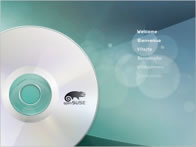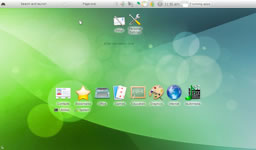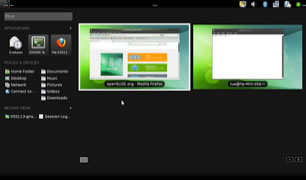Sortware Review: By Drew Kwashnak
openSUSE startup screen OpenSUSE, a Linux distribution started and still popular in Germany, means “sweet” and regardless of how you pronounce it, this distribution lives up to its name. Personally I pronounce Suse similar to Zeus, but I have no practical experience with German so who am I to say anything? OpenSUSE is one of the few distributions available on a Live CD as well as DVD, where you can choose to install whichever desktop environment, packages and applications you want. Traditional Live CDs of Gnome and KDE desktop environments are available for easy installation with their compliment of applications carefully selected. This latest release includes some new features as well as the usual complement of updated versions of applications and kernel. Of course the flagship application, Yast (Yet another Setup Tool), is still included to provide a single point to configure the system tools and services. Already available as a graphical application or as a command line application, openSUSE is developing Yast Web which will provide the full power of using Yast to manage a system, but accessed through a web browser just like one probably used to set up a router or modem. People using openSUSE for their personal computers have a number of changes to look forward to. LXDE, Plasma Netbook Workspace & Gnome-Shell Starting with desktop environments, openSUSE has added to its default KDE and available Gnome desktops the option to install LXDE, or Lightweight X11 Desktop Environment. This desktop environment has been growing increasingly popular with lower-powered machines such as netbooks and older machines as it is much lighter on resources than the more traditional environments. Speaking of Netbooks, openSUSE includes two desktop environments aimed at the diminutive screens and power-sipping chips of popular netbooks including the new Plasma Netbook Workspace. This KDE desktop environment, which openSUSE contributes heavily to, is specifically designed for the smaller screens of a netbook. The Plasma Netbook Workspace provides easy access to applications through its Search and Launch interface and includes Internet applications for mail, micro blogging and social networking.
Plasma Netbook Workspace MeeGo, a project headed up by Intel and Nokia, is another netbook-focused desktop environment packaged by the openSUSE Goblin team. This environment provides a visually rich experience for the user and uses the latest Banshee media player, which will include the ability to access the Amazon MP3 store very much like iTunes connects to Apple’s iTunes Store. Of course the traditional KDE and Gnome desktop environments are still available, and even the next generation Gnome environment, the Gnome-Shell is available as an option. This environment is fresh and new, and represents the direction Gnome is going.
Gnome Shell Desktop Smartphones Desktop environments are not the only features improved for the personal computer user. What can be more social and modern than the latest batch of smartphones? Androids, iPhones and Blackberrys have been increasingly popular with their plethora of useful (and not-so-useful) apps and computer-in-your-hand experience. OpenSUSE provides for accessing and syncing your music, photos and files with your smartphone while allowing the phones to act as a gateway to the Internet practically anywhere! SpiderOak While Internet storage is nothing new, openSUSE includes a deal with SpiderOak to provide an easy, secure backup, sync and sharing location. SpiderOak is configurable to sync with Linux, Mac, Windows and smartphones and provides access to files stored in the cloud from practically anywhere. SpiderOak preserves historical versions and deleted files, a means of sharing folders with RSS to alert when changes are made and offers 2 GB for free and 100GB blocks for $10 per month or $100 per year. OpenSUSE users can get a 15% discount for buying additional space. Currently SpiderOak is not open source, so it will be found on the non-OSS add-on DVD. Btrfs File System While there are too many enhancements and upgrades to list here, the last one I am going to go over is the next generation file system Btrfs, which is available from the DVD installer. Btrfs aims to enhance fault tolerance, easy repair and administration, writable snapshots and greater efficiencies. Originally developed by Oracle and now released under the GPL, the Btrfs file system is still under heavy development. Thus, openSUSE allows one to get a sneak peek of this coming technology. So, with many enhancements for netbook users, social media hounds and people connecting anywhere anytime, openSUSE 11.3 has a lot to offer over and above their Enterprise-level offerings which benefits from it’s corporate sponsor, Novell. OpenSUSE releases every 8 months and each version is supported for 2 releases +2 months, meaning 11.3 will be fully supported for 18 months. You can get it either from downloading it from the openSUSE website or if you don’t have broadband or don’t want the hassle, openSUSE is available in a retail box for only $65. Information and screenshots from OMG! SUSE! Meet openSUSE 11.3. Drew Kwashnak is a distro-hopper who has narrowed his movements to the “big three” distros; Ubuntu, Fedora and openSUSE. Every time he gets into openSUSE he intends to develop some application in Mono, the open source and compatible .NET framework for Linux, Mac, Solaris and Windows.
|
 Click Here |
 |
 |
DacsGear!
|


